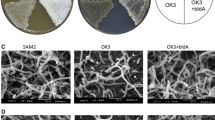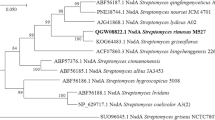Abstract
Proteins MiaA and MiaB catalyze sequential isopentenylation and methylthiolation, respectively, of adenosine residue in 37th position of tRNAXXA. The mia mutations were recently shown by us to affect secondary metabolism and morphology of Streptomyces. However, it remained unknown as to whether both or one of the aforementioned modifications is critical for colony development and antibiotic production. Here, we addressed this issue through analysis of Streptomyces albus J1074 strains carrying double miaAmiaB knockout or extra copy of miaB gene. The double mutant differed from wild-type and miaA-minus strains in severity of morphological defects, growth dynamics, and secondary metabolism. Introduction of extra copy of miaB gene into miaA mutant restored aerial mycelium formation to the latter on certain solid media. Hence, miaB gene might be involved in tRNA thiomethylation in the absence of miaA; either MiaA- or MiaB-mediated modification appears to be enough to support normal metabolic and morphological processes in Streptomyces.





Similar content being viewed by others
References
Agris PF, Koh H, Söll D (1973) The effect of growth temperatures on the in vivo ribose methylation of Bacillus stearothermophilus transfer RNA. Arch Biochem Biophys 154:277–282
Agris PF, Narendran A, Sarachan K et al (2017) The importance of being modified: the role of RNA modifications in translational fidelity. Enzymes 41:1–50
Barends S, Zehl M, Bialek S, de Waal E, Traag BA, Willemse J, Jensen ON, Vijgenboom E, van Wezel GP (2010) Transfer-messenger RNA controls the translation of cell-cycle and stress proteins in Streptomyces. EMBO Rep 11:119–125
Bilyk B, Luzhetskyy A (2014) Unusual site-specific DNA integration into the highly active pseudo-attB of the Streptomyces albus J1074 genome. Appl Microbiol Biotechnol 98:5095–5104
Boccaletto P, Machnicka MA, Purta E, Piątkowski P, Bagiński B, Wirecki TK, de Crécy-Lagard V, Ross R, Limbach PA, Kotter A, Helm M, Bujnicki JM (2018) MODOMICS: a database of RNA modification pathways. 2017 update. Nucleic Acids Res 46:D303–D307
Caillet J, Droogmans L (1988) Molecular cloning of the Escherichia coli miaA gene involved in the formation of delta 2-isopentenyl adenosine in tRNA. J Bacteriol 170:4147–4152
Dal Magro C, Keller P, Kotter A et al (2018) A vastly increased chemical variety of RNA modifications containing a thioacetal structure. Angew Chem Int Ed Engl 57:7893–7897
Engel F, Ossipova E, Jakobsson PJ, Vockenhuber MP, Suess B (2020) sRNA scr5239 involved in feedback loop regulation of Streptomyces coelicolor central metabolism. Front Microbiol 10:3121
Ericson JU, Björk GR (1986) Pleiotropic effects induced by modification deficiency next to the anticodon of tRNA from Salmonella typhimurium LT2. J Bacteriol 166:1013–1021
Esberg B, Leung HC, Tsui HC et al (1999) Identification of the miaB gene, involved in methylthiolation of isopentenylated A37 derivatives in the tRNA of Salmonella typhimurium and Escherichia coli. J Bacteriol 181:7256–7265
Feeney MA, Chandra G, Findlay KC et al (2017) Translational control of the SigR-directed oxidative stress response in Streptomyces via IF3-mediated repression of a noncanonical GTC start codon. MBio 8
González A, Rodríguez M, Braña AF, Méndez C, Salas JA, Olano C (2016) New insights into paulomycin biosynthesis pathway in Streptomyces albus J1074 and generation of novel derivatives by combinatorial biosynthesis. Microb Cell Factories 15:56
Herrmann S, Siegl T, Luzhetska M, Petzke L, Jilg C, Welle E, Erb A, Leadlay PF, Bechthold A, Luzhetskyy A (2012) Site-specific recombination strategies for engineering actinomycete genomes. Appl Environ Microbiol 78:1804–1812
Jackman JE, Alfonzo JD (2013) Transfer RNA modifications: nature’s combinatorial chemistry playground. Wiley Interdiscip Rev RNA 4:35–48
Jones SE, Leong V, Ortega J, Elliot MA (2014) Development, antibiotic production, and ribosome assembly in Streptomyces venezuelae are impacted by RNase J and RNase III deletion. J Bacteriol 196:4253–4267
Kaminska KH, Baraniak U, Boniecki M, Nowaczyk K, Czerwoniec A, Bujnicki JM (2007) Structural bioinformatics analysis of enzymes involved in the biosynthesis pathway of the hypermodified nucleoside ms2io6A37 in tRNA. Proteins Struct Funct Bioinforma 70:1–18
Kellner S, Neumann J, Rosenkranz D, Lebedeva S, Ketting RF, Zischler H, Schneider D, Helm M (2014) Profiling of RNA modifications by multiplexed stable isotope labelling. Chem Commun (Camb) 50:3516–3518
Kieser T, Bibb MJ, Buttner MJ et al (2000) Practical Streptomyces genetics. The John Innes Foundation, Norwich
Kirchner S, Ignatova Z (2015) Emerging roles of tRNA in adaptive translation, signalling dynamics and disease. Nat Rev Genet 16:98–112
Koshla O, Lopatniuk M, Rokytskyy I, Yushchuk O, Dacyuk Y, Fedorenko V, Luzhetskyy A, Ostash B (2017) Properties of Streptomyces albus J1074 mutant deficient in tRNALeuUAA gene bldA. Arch Microbiol 199:1175–1183
Koshla O, Yushchuk O, Ostash I, Dacyuk Y, Myronovskyi M, Jäger G, Süssmuth RD, Luzhetskyy A, Byström A, Kirsebom LA, Ostash B (2019) Gene miaA for post-transcriptional modification of tRNAXXA is important for morphological and metabolic differentiation in Streptomyces. Mol Microbiol 112:249–265
Leung H-CE, Chen Y, Winkler ME (1997) Regulation of substrate recognition by the MiaA tRNA prenyltransferase modification enzyme of Escherichia coli K-12. J Biol Chem 272:13073–13083
Mathevon C, Pierrel F, Oddou J-L, Garcia-Serres R, Blondin G, Latour JM, Menage S, Gambarelli S, Fontecave M, Atta M (2007) tRNA-modifying MiaE protein from Salmonella typhimurium is a nonheme diiron monooxygenase. Proc Natl Acad Sci U S A 104:13295–13300
McLean TC, Hoskisson PA, Seipke RF (2016) Coordinate regulation of antimycin and candicidin biosynthesis. mSphere:1
Myronovskyi M, Rosenkränzer B, Luzhetskyy A (2014) Iterative marker excision system. Appl Microbiol Biotechnol 98:4557–4570
Olano C, García I, González A, Rodriguez M, Rozas D, Rubio J, Sánchez-Hidalgo M, Braña AF, Méndez C, Salas JA (2014) Activation and identification of five clusters for secondary metabolites in Streptomyces albus J1074. Microb Biotechnol 7:242–256
Ontiveros RJ, Stoute J, Liu KF (2019) The chemical diversity of RNA modifications. Biochem J 476:1227–1245
Persson BC, Björk GR (1993) Isolation of the gene (miaE) encoding the hydroxylase involved in the synthesis of 2-methylthio-cis-ribozeatin in tRNA of Salmonella typhimurium and characterization of mutants. J Bacteriol 175:7776–7785
Persson BC, Olafsson O, Lundgren HK et al (1998) The ms2io6A37 modification of tRNA in Salmonella typhimurium regulates growth on citric acid cycle intermediates. J Bacteriol 180:3144–3151
Phelps SS, Malkiewicz A, Agris PF, Joseph S (2004) Modified nucleotides in tRNA(Lys) and tRNA(Val) are important for translocation. J Mol Biol 338:439–444
Pierrel F, Douki T, Fontecave M, Atta M (2004) MiaB protein is a bifunctional radical-S-adenosylmethionine enzyme involved in thiolation and methylation of tRNA. J Biol Chem 279:47555–47563
Sambrook J, Russell DW (2001) Molecular cloning: a laboratory manual, 3rd edn. Cold Spring Harbor Laboratory Press, New York
Schweizer U, Bohleber S, Fradejas-Villar N (2017) The modified base isopentenyladenosine and its derivatives in tRNA. RNA Biol 14:1197–1208
Sehin Y, Koshla O, Dacyuk Y, Zhao R, Ross R, Myronovskyi M, Limbach PA, Luzhetskyy A, Walker S, Fedorenko V, Ostash B (2019) Gene ssfg_01967 (miaB) for tRNA modification influences morphogenesis and moenomycin biosynthesis in Streptomyces ghanaensis ATCC14672. Microbiology 165:233–245
Shigi N (2014) Biosynthesis and functions of sulfur modifications in tRNA. Front Genet 5:67
Thompson KM, Gottesman S (2014) The MiaA tRNA modification enzyme is necessary for robust RpoS expression in Escherichia coli. J Bacteriol 196:754–761
Vold BS, Longmire ME, Keith DE (1981) Thiolation and 2-methylthio- modification of Bacillus subtilis transfer ribonucleic acids. J Bacteriol 148:869–876
Yu JM, Wang D, Pierson LS, Pierson EA (2017) Disruption of MiaA provides insights into the regulation of phenazine biosynthesis under suboptimal growth conditions in Pseudomonas chlororaphis 30-84. Microbiology 163:94–108
Acknowledgments
National Research Foundation of Ukraine is thanked for support (to B.O.). A. Pavlenko is thanked for initial experiments on complementation of miaA mutants with miaB gene.
Funding
R.D.S. and B.O. received funding from the Bundesministerium für Bildung und Forschung (BMBF) project 021DK17013 AWAKEDRUGS.
Author information
Authors and Affiliations
Corresponding author
Additional information
Publisher’s note
Springer Nature remains neutral with regard to jurisdictional claims in published maps and institutional affiliations.
Electronic supplementary material
ESM 1
(PDF 2148 kb)
Rights and permissions
About this article
Cite this article
Koshla, O., Kravets, V., Dacyuk, Y. et al. Genetic analysis of Streptomyces albus J1074 mia mutants suggests complex relationships between post-transcriptional tRNAXXA modifications and physiological traits. Folia Microbiol 65, 1009–1015 (2020). https://doi.org/10.1007/s12223-020-00811-7
Received:
Accepted:
Published:
Issue Date:
DOI: https://doi.org/10.1007/s12223-020-00811-7




